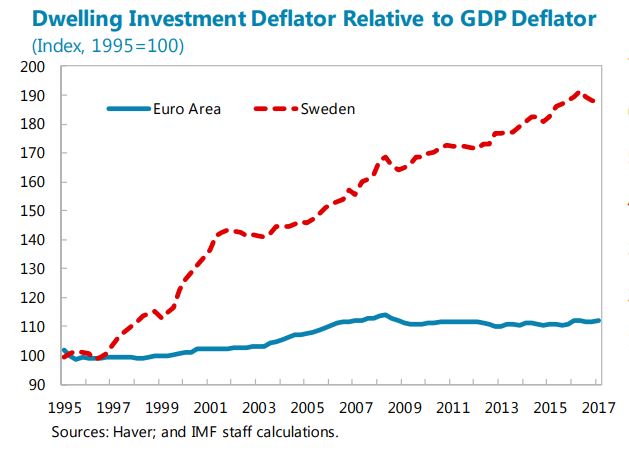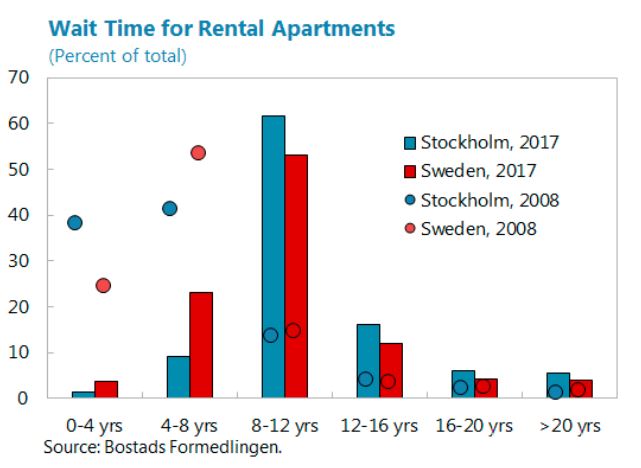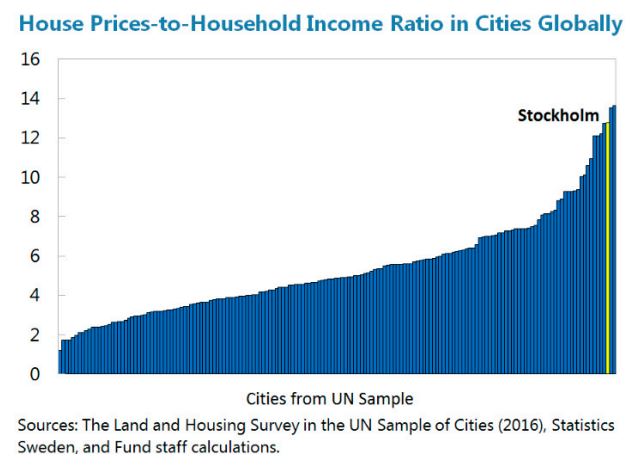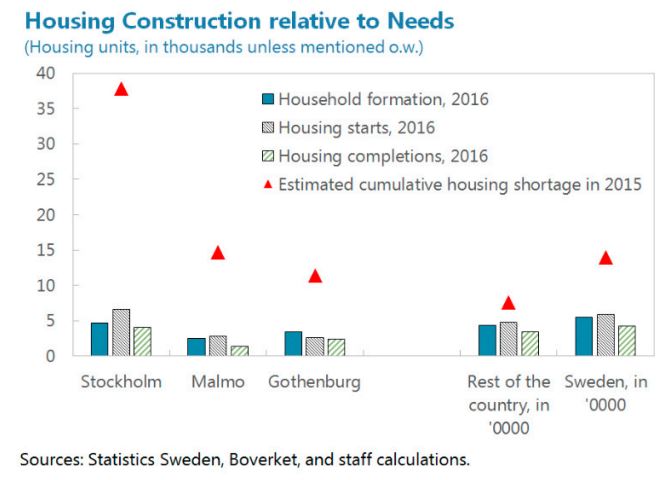Monday, November 20, 2017
Housing in Sweden
From IMF’s latest report on Sweden:
“The Swedish housing market has deep structural problems. Large house price increases were necessary to overcome the hurdle of high construction costs before construction began rising. These costs reflect a combination of complex building regulations and limited competition in the sector owing to cumbersome municipal land sale and planning and approval procedures. The resulting supply shortfalls are present in 255 out of 290 municipalities, but are mostly in the three major metropolitan areas (Stockholm, Gothenburg, and Malmo) owing to ongoing urbanization. Moreover, strict rent controls have resulted in a declining supply of rental apartments as they are converted into tenant-owned condominiums and as existing renters are “locked-in”. The resulting long waiting times for rental apartments leave many households with no option but to purchase housing, which is incentivized by the tax deductibility of mortgage interest payments.”
“Low housing affordability undermines financial stability, growth, and equality. Home costs relative to median household income have more than doubled since the mid-1990s (…). In Stockholm, the price-to-income ratio is nearly twice the national average and is among the highest worldwide. These factors reduce labor mobility, especially for those from outside the main centers, hindering inclusive growth. Equity is further undermined by overcrowding among low-income groups and the need to rely on parental savings for housing purchases. Households must borrow more at higher house prices, lifting household debt to 182 percent of disposable income (…), with new purchasers taking on debts averaging 402 percent of their disposable income.”
“Policies to bolster construction are welcome yet are unlikely to be sufficient to rebalance the housing market. The government targets building 250,000 dwellings during 2015– 20, including by subsidizing (0.1 percent of GDP) construction of affordable rental housing—which meets energy efficiency and rent limit requirements—and through state financing to municipalities for infrastructure related to housing development. Although construction has risen (…), housing starts only modestly exceed estimated household formation in most of the country, indicating that shortages will persist. Moreover, due to high land prices and construction costs, new development has been focused on the high-end of the market or located in more remote areas.”
“Improving housing affordability should be a central priority, supported by deep structural reforms to promote more efficient use of existing property:
- Sustaining housing supply. High construction costs in Sweden need to be addressed by streamlining building regulations and promoting competition in the sector, including by harmonizing fragmented planning and approval processes. Improving public transportation within regions would help relieve demand pressures in major centers. Budgetary support for construction of rental housing that meets affordability tests should be expanded.
- Phasing out rent control. Providing incentives to better match housing to household needs will effectively increase supply in areas with high demand. All new construction of rental apartments should be fully exempt from controls. Rents on apartments under control should be steadily aligned with market rates, with low-income households protected by the housing allowance.
- Addressing tax incentives. To promote efficient use of space, the composition of property taxes should be shifted by cutting capital gains taxes that deter sales while raising the recurrent property tax, which in 2008 was capped at a level among the lowest in OECD. If the property tax cannot be raised, it becomes more critical to reduce mortgage interest deductibility to ease demand and discourage high leverage. The macroeconomic impact would be modest while interest rates are low and such reforms could be part of a package that benefits households.”
“Authorities’ Views. The authorities recognize the structural challenges in the Swedish housing market, as reflected in the appointment of committees to review the planning and building regulations as well as the model for setting rents on newly produced rental housing. The authorities also recognize the need for further measures to reduce incentives for over-indebtedness. Political opposition to property tax is strong as it is considered to be unfair, and while a lower capital gains tax could improve property turnover, it could have distributional effects favoring older households that had often accumulated significant wealth. The government’s view is that a reduction in mortgage interest deductibility is more feasible if broad political consensus can be reached. With rents on newly-produced rental properties being very high, the government is concerned that a transition to market-based rents would bring high rents, and it also has doubts that the supply of rental housing within the reach of lower income households would increase significantly. The Riksbank, on the other hand, stresses that a more market-based rent system would increase supply, benefitting young people.”
Posted by at 1:29 PM
Labels: Global Housing Watch
Subscribe to: Posts



